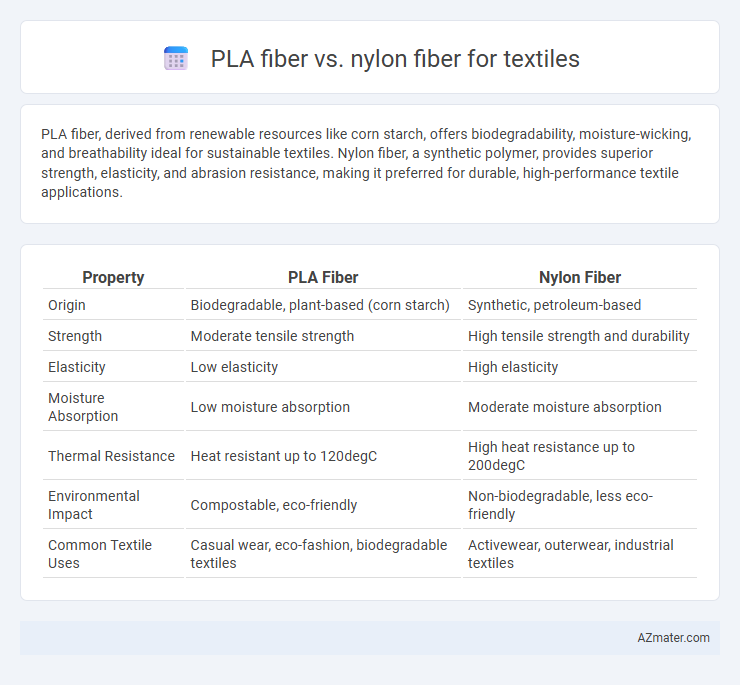PLA fiber, derived from renewable resources like corn starch, offers biodegradability, moisture-wicking, and breathability ideal for sustainable textiles. Nylon fiber, a synthetic polymer, provides superior strength, elasticity, and abrasion resistance, making it preferred for durable, high-performance textile applications.
Table of Comparison
| Property | PLA Fiber | Nylon Fiber |
|---|---|---|
| Origin | Biodegradable, plant-based (corn starch) | Synthetic, petroleum-based |
| Strength | Moderate tensile strength | High tensile strength and durability |
| Elasticity | Low elasticity | High elasticity |
| Moisture Absorption | Low moisture absorption | Moderate moisture absorption |
| Thermal Resistance | Heat resistant up to 120degC | High heat resistance up to 200degC |
| Environmental Impact | Compostable, eco-friendly | Non-biodegradable, less eco-friendly |
| Common Textile Uses | Casual wear, eco-fashion, biodegradable textiles | Activewear, outerwear, industrial textiles |
Overview of PLA Fiber and Nylon Fiber
PLA fiber, derived from renewable resources like corn starch, offers biodegradability and excellent moisture-wicking properties, making it ideal for eco-friendly textile applications. Nylon fiber, a synthetic polymer known for its high strength, elasticity, and abrasion resistance, is widely used in durable and performance-driven textiles. Both fibers cater to different market needs, with PLA supporting sustainability trends and Nylon excelling in resilience and versatility.
Production Processes of PLA and Nylon Fibers
PLA fiber production involves the polymerization of lactic acid derived from renewable resources like corn starch and sugarcane, followed by melt spinning to form fibers, making it a biodegradable option with lower environmental impact. Nylon fiber production relies on the polycondensation of petroleum-based monomers such as adipic acid and hexamethylene diamine, processed through melt or solution spinning to create durable synthetic fibers. The energy-intensive synthesis and petrochemical origin of nylon contrast with the bio-based, sustainable feedstock and milder processing conditions of PLA fibers.
Environmental Impact: PLA Fiber vs Nylon Fiber
PLA fiber is derived from renewable resources like cornstarch, making it biodegradable and compostable under industrial conditions, which significantly reduces its environmental footprint compared to conventional petrochemical-based nylon fiber. Nylon production involves high energy consumption and releases nitrous oxide, a potent greenhouse gas, contributing to greater environmental pollution and carbon emissions during its lifecycle. While PLA fiber excels in sustainability through lower greenhouse gas emissions and biodegradability, nylon offers higher durability and strength but at the cost of increased ecological impact.
Mechanical Properties: Strength and Durability
PLA fiber exhibits high tensile strength with excellent biodegradability, making it suitable for eco-friendly textiles with moderate durability. Nylon fiber outperforms PLA in terms of superior abrasion resistance, elasticity, and long-term durability, ideal for heavy-duty and performance textiles. Mechanical properties of Nylon such as impact resistance and load-bearing capacity exceed those of PLA, making Nylon a preferred choice where strength and longevity are critical.
Moisture Management and Breathability
PLA fiber exhibits superior moisture management compared to nylon fiber due to its hydrophilic properties, which enable faster absorption and quicker drying times. This biobased fiber enhances breathability by allowing better air circulation and moisture vapor permeability, making it ideal for activewear and performance textiles. Nylon fiber, while durable and strong, tends to retain moisture and has lower breathability, often leading to discomfort during prolonged wear or intense physical activities.
Comfort and Skin Sensitivity
PLA fiber, derived from renewable resources like corn starch, offers superior breathability and moisture-wicking properties, enhancing comfort in textile applications. Unlike nylon fiber, PLA is hypoallergenic and less likely to cause skin irritation, making it suitable for sensitive skin. Nylon, though durable and elastic, can trap heat and moisture, potentially leading to discomfort and skin sensitivity issues.
Biodegradability and Sustainability
PLA fiber, derived from renewable resources like corn starch, offers superior biodegradability compared to conventional nylon fiber, which is petroleum-based and can persist in the environment for decades. PLA fibers decompose under industrial composting conditions within months, significantly reducing landfill waste and microplastic pollution linked to nylon textiles. Sustainable textile production increasingly favors PLA due to its lower carbon footprint, renewable input materials, and compatibility with circular economy principles, contrasting sharply with the fossil fuel dependency and slow degradation of nylon fibers.
Dyeability and Aesthetic Potential
PLA fiber exhibits excellent dyeability due to its high affinity for water-based dyes, resulting in vibrant and long-lasting colors ideal for fashion textiles. Nylon fiber also shows superior dye uptake with acid and disperse dyes, offering a broad color spectrum and rich tonal depth favored in performance wear and lingerie. PLA fibers tend to provide a matte and soft aesthetic, while nylon fibers deliver a smooth, glossy finish, enhancing the textile's appeal based on the desired visual effect.
Cost Comparison in Textile Applications
PLA fiber typically costs more than nylon fiber due to its bio-based production process and higher raw material expenses. Nylon fiber, derived from petrochemicals, benefits from established mass production techniques that lower its price point significantly. In textile applications, the cost advantage of nylon fiber makes it preferred for large-scale manufacturing where budget constraints are critical.
Future Prospects for PLA and Nylon in Textiles
PLA fiber offers significant sustainability advantages due to its biodegradability and renewable plant-based origins, making it increasingly attractive for eco-conscious textile markets. Nylon fiber maintains dominance in performance applications with high durability, elasticity, and moisture resistance, ensuring its continued use in activewear and technical textiles. Innovations in biopolymer technology and recycling processes could enhance PLA's competitiveness, while advancements in nylon recycling aim to reduce environmental impact, shaping future textile industry trends.

Infographic: PLA fiber vs Nylon fiber for Textile
 azmater.com
azmater.com